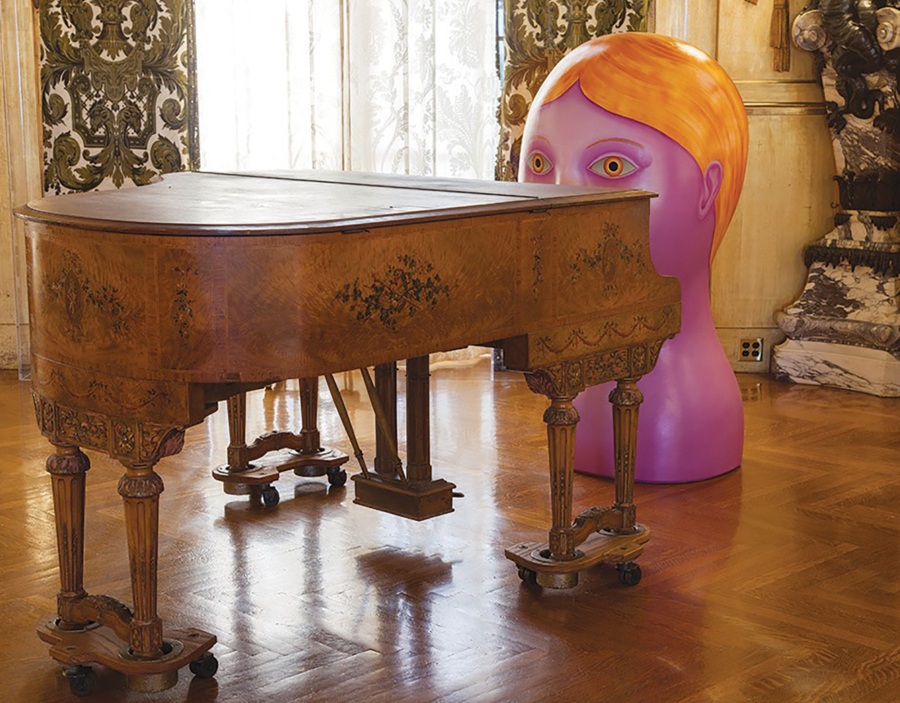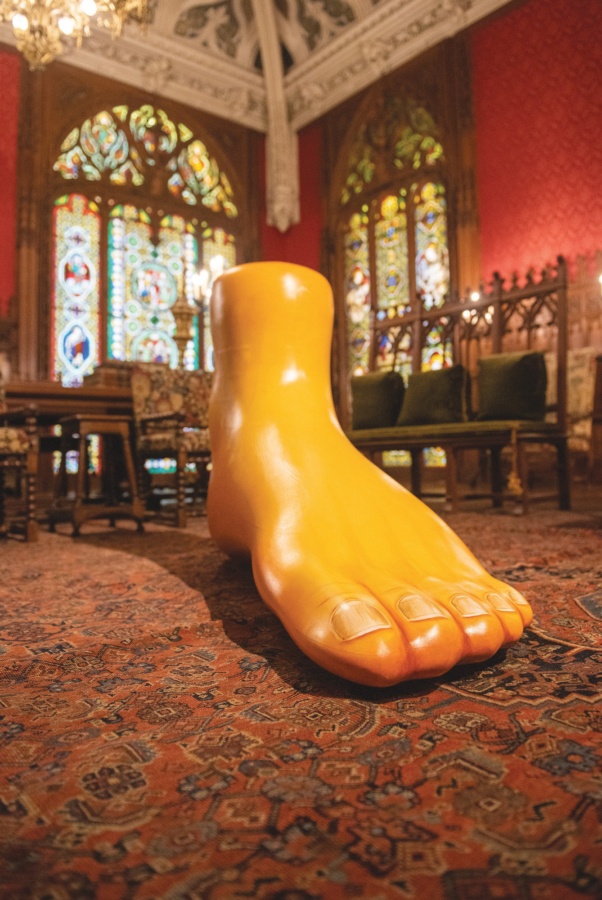August 29, 2019
Download as PDF
View on Newport this week
It’s hard to imagine what could shock and awe in a room made of 22 carat gold leaf, but a large sculpture of a head, with a purple face and orange hair, glossy and serene, positioned in front of a piano, with yellow-orange eyes just peeking over, has the effect of surprise.
It’s outlandish enough that some have wondered if it’s part of the original decor, which was the work of Alva Vanderbilt, wife of William K. Vanderbilt, who built Marble House on Bellevue Avenue in the late 1880s.
While the work may be more reflective of the 21st than the 19th century, it speaks to art themes that have been around for much longer, like how one captures and conveys the human form, especially within the context of portraiture.
The giant head is the work of Nicolas Party, and is one of many pieces currently on display as part of “Marble Ghosts: Nicolas Party at Marble House,” an exhibit that runs through Sept. 22.

The juxtaposition of incongruous objects at Marble House is the inspiration for artist Nicolas Pary’s exhibition. (Photo courtesy of the artist and Karma, New York. Photographed by: Jesse Sullivan)
The exhibit is a collaboration between The Preservation Society of Newport County, which oversees Marble House, and Art & Newport, which curated the work. Art & Newport was founded by Dodie Kazanjian in 2017 with the intention of developing and hosting a series of citywide visual arts presentations throughout the year.
Kazanjian grew up in Newport and attended Salve Regina University, and is a longtime arts writer for Vogue as well as the founding director and curator of Gallery Met at the Metropolitan Opera in New York. She had a vision for showcasing Party’s work, and invited him here twice last year to scope out the best location for his installations.
On a rainy afternoon in November, they found themselves at Marble House, and decided that was the ideal location, particularly as it allowed for an exploration of faux versus real materials, marble among them, and a playful approach to examining portraiture within historical contexts. Kazanjian made her case to The Preservation Society, which has its own initiative to bring more art to its properties, and a partnership was formed.
“I wanted to figure out a way I could give back to Newport,” Kazanjian said of founding Art & Newport, which is nonprofit. “My mind went to George Wein and what he was able to do in 1954 with the jazz festival. He made Newport international all over again for a different reason.
“We want to add something to existing institutions,” she said. “There are many different ways we can play in this town.”

The juxtaposition of incongruous objects at Marble House is the inspiration for artist Nicolas Pary’s exhibition. (Photo courtesy of the artist and Karma, New York. Photographed by: Jesse Sullivan)
From his studio in Brooklyn, Party began working on pieces for Marble House. Born in Switzerland, he began his art career as a graffiti artist, becoming “one of the most provocative and innovative artists of his generation,” according to Kazanjian.
“He gives us a portrait in many different ways,” she said. “He can stretch us, he can make us think, and he can also give us something of the past.”
At the conclusion of the exhibit, which ends with the tour in the basement of the building, Party asks in a video, “What is a portrait that will not be either a man or a woman, but more like this idea of a portrait of an ideal face?”
The video shows Party at work in his large, light-filled studio, mostly white except for his colorful pieces, as he discusses his process and the thinking behind his “alien-like” creations, as well as his use of certain materials.
“Portrait is an important part of the pastel work and also the sculpture work,” he explains.
When visitors arrive at Marble House, they are given headsets that offer context for the work that is positioned around the house, which otherwise has no explanation. Party’s installations range from several large androgynous heads in varying color palettes and smaller, more lifelike marble cats to full figures that are vertical and horizontal, busts that are playful and a bit surreal and even a single foot.
“The artwork you’ll encounter today may come as a bit of a surprise, but remember, everything that is old was once new,” a narrator tells those listening through a headset. “Party wants his works to begin a conversation with this Gilded Age setting. As you experience this unusual juxtaposition, you’ll become part of this conversation, too. What will you add to the dialogue? Your answer may change as you move through the tour. We hope that, through the installation, you will not only enjoy the art of Nicolas Party, but also view Marble House from a new perspective.”
“This is not art for art’s sake,” said Leslie Jones, director of museum affairs and chief curator at The Preservation Society, noting guests should view the work and consider what “contemporary” means to different time periods. “The sculptures work so well in these spaces, it’s uncanny. I think that’s a distinct part of [Party’s] talent.
“A foot in the midst of a Gothic decorated room is not something one would expect, yet here we are,” she said.



